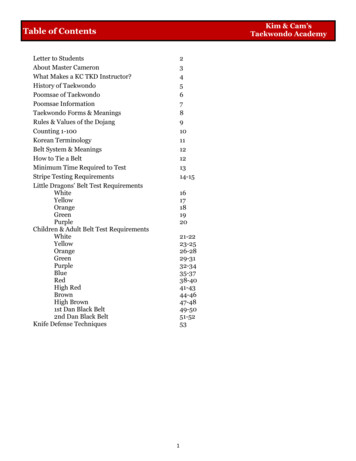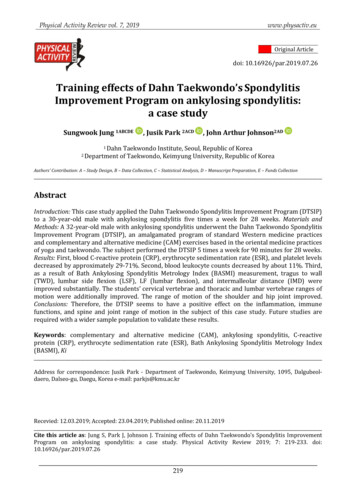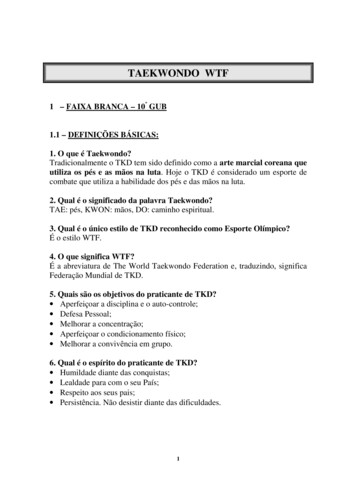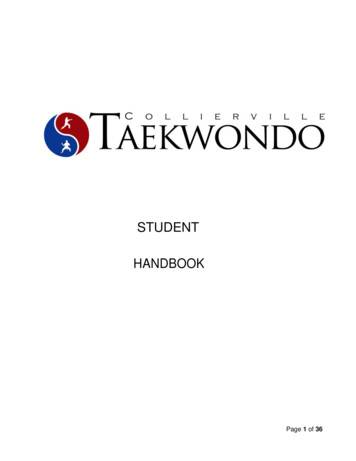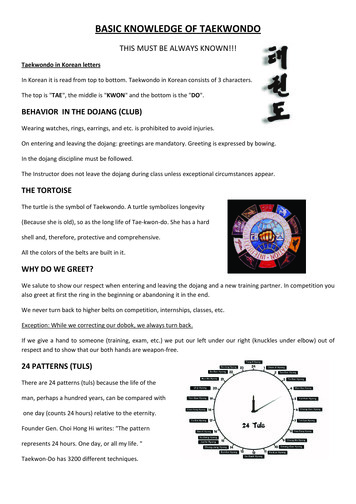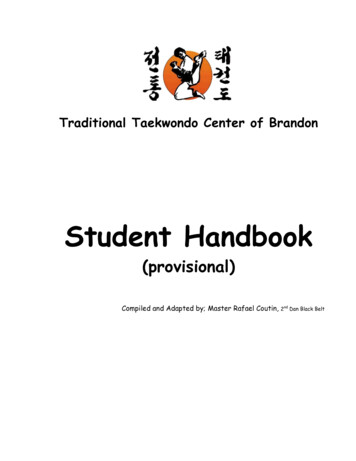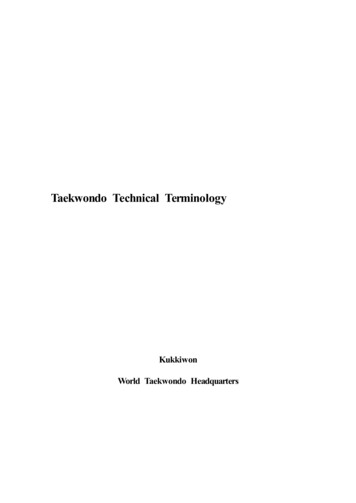
Transcription
Taekwondo Technical TerminologyKukkiwonWorld Taekwondo Headquarters
Page 1PrefaceCommemorating the publication of Taekwondo Terminology.March 1, 2012Dear Members of the Taekwondo FamilySince the Kukkiwon was founded in 1973, the Taekwondo Textbook has beenpublished and revised in 1987 and 2005 respectively. However, there is stillsome difficulty in communication within the taekwondo community wheretechnical terminology is frequently used.Due to the lack of coherence and uniformity in the technical terminology,formulating the names of new techniques has not been easy and different peoplehave used different names for the same techniques. In addition, some technicalterms are too long to learn and non‐Koreans have difficulty pronouncing them inKorean. On the other hand, the terms for sparring and demonstration have notbeen regulated, creating confusion among the players and participants. Thus,there has been an urgent need for the standardization of the technicalterminology of taekwondo.In order to respond to the demand, the Kukkiwon started to collect and reviewthe technical terms used in dojang (martial art studios) and competition arenasover the past two years and finally selected 138 terms. The outcome of theefforts is now compiled in the present book with the explanation of eachtechnique.The standardized Taekwondo Technique Terminology has accomplished thecoherence, uniformity, and simplicity needed for these terms. The book has alsoincluded contents missing from the Taekwondo Textbook regarding subjects suchas the methodology and direction of techniques and other omitted techniques.
From now on, the names of new techniques can be formulated with coherenceand pronounced with brevity in five syllables so that they can be easily learnedand used where taekwondo is taught and practiced. Since the pronunciation ofKorean words has been adapted according to the romanization system of theNational Institute of the Korean Language, the taekwondo terms will bepronounce the same way all around the world.By publishing the present compilation of terminology, the various skills ofsparring, breaking, self-defense including the present official poomsae (patterns)will be easily and correctly expressed and eventually helpful to the first-lineleaders and the academic world. Nevertheless, the present work cannot bewithout flaws; thereby, we will continuously improve it through thoroughresearch.With an eye to the future, the Kukkiwon will serve the members of the globaltaekwondo community by developing a new prototype of martial arts throughextensive study of original techniques and theory. We anticipate your continuoussupport and affection for taekwondo.Thank you.Kang, Won SikThe President of Kukkiwon
Introductory Remarks Range of Main EntriesThe present collection of technical terminology contains various headings fromPoomsae (forms), Gyeorugi (sparring), Gyeokpa (breaking) and Hoshinsul(self‐defense), which constitute the basics of Taekwondo skills. Arrangement of Main EntriesThe headings are arranged and written in the order of the Roman alphabet. Arrangement of InformationAll technical headings written in Korean are transcribe in the Roman alphabetsaccording to the pronunciation of standard Korean. In addition, both brief andfull descriptions of each heading are provided in separate paragraphs. Underneaththe descriptions, the usage of heading is suggested with its synonyms. Example Romanization of Technical Term Original Term in Korean Term in theNative Language Brief Description Full Description Use of Skill Sub Heading (Omitted Wording) [ Synonym] Signs Use of Technique Sub-headings( ) Omittable Wording[ ]Synonyms
Criteria for the Standardization of Terminology1. Basics of TaekwondoWhen Taekwondo techniques are broken down, the smallest meaningful unitsof technical terms, which cannot be split any smaller, are defined as ‘the basicsof Taekwondo.’2. Technical TerminologyVarious techniques, tactics, etc. based on the basics of Taekwondo are referredto as ‘technical terminology.’ This includes all kinds of skills performed inPoomsae (patterns), Gyeorugi (sparring), Gyeokpa (breaking) and Hoshinsul(self‐defense). Example Poomsae: Bakkat-makgi (Outward Block)Gyeorugi: Narae-chagi (Double Kick)Gyeokpa: 540 Dwihuryeo-chagi (540 Back Whip Kick)Hoshinsul: Georeo-neomgigi (Trip & Sweep)3. Composition of TerminologyThe technical terms of Taekwondo are arranged in the order of ‘applicablepart of the body method skill.’4. Synonyms of TerminologyThe synonyms of some technical terms are included and can be usedinterchangeably. Gyeorugi-junbi (Sparring Posture) [ Gyeorumsae] Du-palgup-yeop-chigi (Two Elbow Yoke Strike) [ Meongae-chigi] Dwidora-ttwieo-dollyeo-chagi (Back Jumping Spin Kick) [ Dolgae-chagi]
Ttwieo-ieo-dollyeo-chagi (Double Kick) [ Narae-chagi] Ttwieo-ieo-ap-chagi (Alternate Jumping Front Kick) [ Dubaldangseong-chagi] ock)[ Arae-makgi] (Bakkatpalmok) An-makgi (Outside Wrist Inward Block) [ Momtong-makgi] (Bakkatpalmok) Ollyeo-makgi (Outside Wrist Upward Block) [ Oelgul-makgi] Ageumson Ap-chigi (Arc Hand Forward Strike) [ Kaljaebi] Anpalmok Ollyeo-makgi (Inside Wrist Upward Block) [ Kkeuleo-olligi]5. Classification of the Applicable Parts of BodyDifferent body parts are used for different techniques and are classified t),Anpalmok(InsideWrist),Deungpalmok (Back of the Wrist), Gupinsonmok (Bent Wrist), Apchuk (Ball of theFoot), Baldeung (Instep of the Foot), Balnal (Foot Blade), Balnaldeung (Inside Edge ofthe Foot or Reverse Foot Blade), Balbadak (Sole of the Foot) and Jeonggangi (Shin)Jireugi(Punching): Jumeok (Fist), Pyeonjumeok (Half‐clenched Fist or Flat Fist),Bamjumeok (Extended Knuckle Fist), Jipgejumeok (Pincers Fist) and Jipgebamjumeok(Trigger Finger Fist)Jjireugi(Thrusting): Pyeonsonkkeut (Flat Fingertips or Spear Hand), Gawisonkkeut(Scissors Fingertips), Hansonkkeut (Single Fingertip), Moundusonkket (Combined TwoFingertips) and Mounsesonkket (Combined Three Fingertips)Jjikgi(Chopping): Modumsonkkeut (Combined Fingertips)Chigi(Striking): Deungjumeok (Back Knuckle), Mejumeok (Hammer Fist), Sonnal(Knife Hand), Sonnaldeung (Reverse Knife Hand), Sondeung (Back of the Hand or BackHand), Gomson (Bear Hand), Batangson (Heel of the Palm or Palm Heel), Gupinsonmok(Bent Wrist), Ageumson (Arc Hand), Palgup (Elbow) and Mureup (Knee)
Chagi(Kicking): Apchuk (Ball of the Foot), Dwichuk (Heel of the Foot), Dwikkumchi(Back of the Heel), Balkkeut (Tips of the Toes), Balnal (Foot Blade), Balnaldeung(Inside Edge of the Foot or Reverse Foot Blade), Balbadak (Sole of the Foot) andBaldeung (Instep of the Foot)6. Method of ClassificationThe terms are classified according to the ‘shape, motion and direction’ of themethods as follows:[Shape]Arm: gawi (scissors), geumgang (Geumgangyeoksa Statue), nalgae (wing), ‘ㄷ’ ordigeutja (a Korean letter), meonge (yoke), bawi (rock), santeul (mountain), oe-santeul(single mountain), jebipum (swallow), chetdari (fork), taesan (steep mountain), pyojeok(target) and hwangso (bull)Leg: gawi (scissors), gyeotdari (assisting leg), bandal (crescent moon), and hakdari (acrane standing on one foot)[Motion]Arm: dollyeo (turn), biteureo (twist), eopeo (turn down or horizontal), jeocheo (turnover or upside down), sewo (turn up or vertical), geodeureo (support), eotgeoreo (cross),dangyeo (pull), mireo (push), geodeo (deflect or parry), bada (absorb), nulleo (press),hwidulleo (swing) and japgo (hold or grab)Leg: georeo (trip), nakka (hook), dollyeo (turn), ttwieo (jump or leap), mireo (push),balbucheo (skip), jejari (in place), gulleo (stamp) and jitjjiki (stamping on the instep).Trunk: gulleo (roll), neomeo (jump over), teureo (turn), biteureo (twist) sugyeo(ducking or bend forward), jeocheo (lean backward)[Direction]
Ollyeo (upward), naeryeo (downward),ap (forward or front), dwi (backward, back orrear), yeop (side or sideways), mo (diagonal), bakkat (outward, outside or outer) and an(inward, inside or inner)7. Classification of TechniquesThe techniques of Taekwondo are classified as follows:[Techniques]Kkeokgi (snapping), neomgigi (throwing down or tripping up), makgi (blocking), ppaegi(pulling out), jireugi (punching), jjireugi (thrusting), jjikgi (chopping), chagi (kicking),chigi (striking) and pihagi (evading or dodging)[Auxiliary Techniques]Ditgi (stepping), ttwigi (jumping), milgi (pushing), seogi (stance) and japgi (grabbing)8. Description of the Left and Right SideSeogi (Stance) is described as explained below. The rest of the skills aredescribed according to the side of the advancing arm or leg.When standing on a single leg, ‘the left or right side’ is determined by thesupporting leg. This rule is applied to Gyeotdari-seogi (Assisting Stance),Hakdari-seogi (Crane Stance), Ogeum-seogi (Inner Knee Stance) and so on. Example Wen-hakdari-seogi (Left Crane Stance) is standing on the left legOren-ogeum-seogi (Right Inner Knee Stance) is standing on the right legWhen performing Kkoa-seogi (Cross Stance), the moving foot becomes thecriterion as to whether it is the front/rear or the left/right. Example Wen-ap-kkoa-seogi – The left is the supporting leg and it crosses over the other leg.
Oren-dwi-kkoa-seogi – The right is the supporting leg and it crosses behind the otherleg.When one side is bent more than the other side, the lower leg becomes thecriterion for ‘left or right.’ This rule is applied to Apgubi (Forward Stance),Dwitgubi (Back Stance), ‘ㅗ’ seogi or Ojja-seogi (Ojja Stance, named after theKorean letter), etc. Example Wen-apgubi – The left leg is in front of other leg in the posture of Apgubi (ForwardStance).Oreun-apgubi – The right leg is behind in the posture of Dwigubi (Backward Stance).When both legs are in the same shape, the advancing foot becomes thecriterion for the name. If the left foot is in front, the name starts with ‘left.’This rule is applied to Mo-narani-seogi (Diagonal Parallel Stance),Mo-juchum-seogi (Diagonal RidingBeom-seogi (Tiger Stance), etc.Stance),Ap-seogi(WalkingStance), Example Wen-mo-juchum-seogi – the left leg is in front in the posture of Mo-narani-seogi(Diagonal Parallel Stance)Oreun-beom-seogi – the right leg is in front in the posture of Beom-seogi (TigerStance).9. Expression of PostureWhen the direction of the body including the degree of bending one’s legsand motion of one’s arms and legs, occur all at once in one posture; the termsas shown below can be used as commands while instructing. Example Juchum-seogi-momtong-jireugi – a punch to the trunk in a Horseback Riding StanceNachueo-juchum-seogi – Lower Horseback Riding StanceApgubi-sonnal-an-makgi – Knife Hand Inward Block in Forward Stance
10. Description of Target Area in Offense and DefenseTarget areas in offense and defense are omitted in principle; however, theycan be used as preparatory commands while instructing. When giving moreelaborate explanations of Poomsae (forms), the detailed target areas can beutilized as follows:[Target areas in Offense and Defense]Eolgul (Face) / Momtong (Trunk) / Arae (Lower Body)[Detailed Target]Philtrum (Injung), chin, neck, waist, temple, solar plexus (myeongchi), back, knee,instep, target (one's own open hand), wrist area (palmok), wrist joint (sonmok), ankle,head, shoulder, elbow, underneath the jaws (tteok mit), and groin (nangsim). example (Eolgul) Batangson-ap-chigi – Palm Heel Forward Strike in the face(Momtong) Mejumeok-bakkat-chigi – Hammer Fist Outward Strike in the trunk(Arae) Pyeonsonkkeut-jeocheo-jjireugi – Flat Fingertips or Spear Hand Turned-overThrust in the lower body11. Terminology of Breaking TechniquesThe breaking techniques are expressed as follows:[Expression in Height and Number of Targets]The difference in terms of height is expressed as Dangye and the number of targetBang. The wording of breaking techniques can be either omitted if they are toocomplicated or expressed simply as Dabangyang-gyeokpa (Multi-direction Break) Example Dollyeo-chagi se-dangye –Gawi-chagi daseot-bangTurn Kick in three different levels of height– Scissors Kick in the form of five different targets
Contents1. Chagi(차기): Kicking2. Chigi(치기): Striking3. Ditgi(딛기): Stepping4.5.6.7.Japgi(잡기): GrabbingJireugi(지르기): PunchingJjireugi(찌르기): ThrustingJjikgi(찍기): Chopping8. Junbi-jase(준비자세): Ready Posture9. Kkeokgi(꺾기): Locking10. Makgi(막기): Blocking11. Milgi(밀기): Pushing12. Neomgigi(넘기기): Throwing down or Tripping up13. Pihagi(피하기): Evading or Dodging14. Ppaegi(빼기): Pulling out15. Seogi(서기): Stance16. Teuksupum(특수품): Special Forms17. Ttwigi(뛰기): Jumping* AppendixApplicable Parts of the Body (사용부위)Gyeokpa(격파): Breaking
1. Chagi(차기): KickingTechniques of striking a target with the feet by extending or turning legsThey are the skills to dominate the opponent in a confrontation by deliveringa strike with the foot. They are offensive skills using the power generated fromflexing and extending the knee or swinging the leg.An-chagi(안차기): Inward KickA technique of striking a target from the outside to the inside of theperformer with the inside edge of the foot (Reverse Foot Blade)This is a skill that requires swinging of the foot from the outside to theinside with the knee facing upward. This skill is designed to strike the side ofan opponent’s face with the reverse foot blade and is used in such skills asPyojeok-chagi (Target Kick).Ap-chagi(앞차기): Front (Snap) KickA technique to strike a target in front of the performer with the footThis is a skill of delivering a blow to the opponent’s chin, solar plexus,stomach, etc. with one’s instep, the ball of the foot, or heel. Commonly,Ap-chagi is executed by bending the knee and extending it to kick straight intothe target. Occasionally, one can kick straight up to the opponent’s chin andtesticles. One may also push the opponent with the foot to maintain the distancewith him or her. use Dwichuk-ap-chagi / 뒤축 앞차기 / Front Kick with the heel of the foot Ttwieo-dubal-ap-chagi / 뛰어 두발 앞차기 / Jumping Two-foot Front Kick
Ttwieo-ap-chagi / 뛰어 앞차기 / Jumping Front Kick Modum-ap-chagi / 모둠 앞차기 / Drawing Front Kick Baldeung-ap-chagi / 발등 앞차기 / Instep Front Kick Apchuk-ap-chagi / 앞축 앞차기 / Front Kick with the ball of the foot Japgo-ap-chagi / 잡고 앞차기 / Grabbing Front KickBada-chagi(받아차기): Counter-KickA technique of counterattacking the opponent’s attack.When the opponent launches a kicking attack in sparring, one can counter itwith such skills as Dollyeo-chagi (Roundhouse Kick), Naeryeo-chagi (Axe Kick),Dwi-chagi (Back Kick), Dwihuryeo-chagi (Back Whip Kick), etc. This commonterm is used for all such circumstances. use Dwitbal-bada-chagi / 뒷발 받아차기 / Rear Foot Counter-kick Apbal-bada-chagi / 앞발 받아차기 / Front Foot Counter-kickBakkat-chagi(바깥차기): Outward KickA striking technique using the outside edge of the foot (Foot Blade) from theinside to the outside.This is a skill of striking the side of the opponent’s face with the blade ofthe foot by swinging the foot widely with the knee, facing up from the insideto the outside of the performer.Balbucheo-chagi(발붙여차기): Skipping KickA technique of bringing the rear foot to the position of the front foot andimmediately striking the target with the front foot.
This skill is commonly used when the opponent is out of range and/or theperformer cannot reach the opponent from a stationery posture. In order to closethe distance between the performer and the opponent and/or to increase speedand power of the kick, make a skipping step forward with the rear foot andbring it in close to thethe head or trunk ofcombined with kickingRoundhouseKick),heel of the front foot. Simultaneously, deliver a blow tothe opponent with the front foot. When this skill istechniques such as Balbucheo-dollyeo-chagi Balbucheo-huryeo-chagi (Skipping Whip Kick), they can be classified under thisgeneral term.Bandal-chagi(반달차기): Crescent KickA technique of striking the target by swinging the foot inwardIn appearance, it is a striking skill similar to Dollyeo-chagi (RoundhouseKick). However, in this case, the supporting leg does not pivot. Instead, thekicking leg is slightly turned inward to deliver a strike.Biteureo-chagi(비틀어차기): Twisting KickA technique of striking a target from the inside to the outside of the bodywith the instepWhen the opponent advances with Dollyeo-chagi and Naeryeo-chagi, one maytake a step to the left or the right and strike the opponent’s face or trunk fromthe inside to the outside of one’s body. use Ttwieo-biteureo-chagi / 뛰어 비틀어차기 / Jumping Twisting Kick (Baldeung) Biteureo-chagi / (발등) 비틀어차기 / (Instep) Twisting Kick Japgo-biteureo-chagi / 잡고 비틀어차기 / Grabbing Twisting KickDabangyang-chagi(다방향차기): Multi‐direction Kick
Kicking techniques used for striking targets placed in various locations withone leap.This is a skill of breaking several targets located in various directionsconsecutively by throwing oneself up into the air with one big leap.Dolgae-chagi(돌개차기): Tornado KickA technique of turn backward to deliver a kickTo deceive or to strike the opponent harder, the front foot is used as an axisto make a full or more turns backward to deliver a kick. use (360º) Dolgae-chagi / (360도) 돌개차기 / (360º) Tornado Kick 540º Dolgae-chagi / 540도 돌개차기 / 540º Tornado Kick 720º Dolgae-chagi / 720도 돌개차기 / 720º Tornado KickDollyeo-chagi(돌려차기): Roundhouse KickA technique of turning the foot inward to strike a targetThis is a skill of pivoting the supporting leg and completely turning the hipin to strike the opponent’s face or trunk with the ball of the foot or the instep.A turning kick is generally employed to strike the opponent’s vital points suchas temples and ribs with the ball of the foot. In sparring and kicking practice,the instep is utilized in order to expand the area of the striking surface or toavoid injuring the opponent while still getting points. use Gulleo-dollyeo-chagi / 굴러 돌려차기 / Stamping Roundhouse Kick Ttwieo-dollyeo-chagi / 뛰어 돌려차기 / Jumping Roundhouse Kick Modum-dollyeo-chagi / 모둠 돌려차기 / Drawing Roundhouse Kick
Baldeung-dollyeo-chagi / 발등 돌려차기 / Instep Roundhouse Kick Balbuchyeo-dollyeo-chagi / 발붙여 돌려차기 / Skipping Roundhouse Kick Apchuk-dollyeo-chagi / 앞축 돌려차기 / Roundhouse Kick with the ball of the foot Japgo-dollyeo-chagi / 잡고 돌려차기 / Grabbing Roundhouse kickDubaldangseong-chagi(두발당성차기): Flying KickA technique of jumping up and kicking the front target with both feet insequenceThe leading foot (rear foot) is used as a feint motion by kicking it low. Thefollowing foot (front foot) strikes the front target with precision by kicking ithigh.Dwi-chagi(뒤차기): Back KickA technique of striking the target by bending the knee and thrusting backwardThis is a skill of striking the opponent with the heel in his or her stomach orchest. This is generally employed by turning one’s body backward and executinga kick when the opponent is in front. Occasionally, one may deliver a straightkick in a fixed position to the target. use Dwi-chagi / 뒤차기 / Back Kick Ttwieo-dwi-chagi / 뛰어 뒤차기 / Jumping Back KickGawi-chagi(가위차기): Scissors KickA technique of striking two targets simultaneously with both feet widelyseparatedThis is a striking skill to jump and spread both feet in the shape of scissors
and hit two different targets in the air at the same time. One foot employsBiteureo-chagi while the other foot Yeop-chagi (Side Kick). use Gawi-chagi(dubang): Biteureo-chagi Yeop-chagi /가위차기(두 방): 비틀어차기 옆차기 /Sissors Kick(two targets): Twist Kick Side Kick Gawi-chagi-sebang: Gawi-chagi Dollyeo-chagi /가위차기 세 방: 가위차기 돌려차기 /Scissors Kick with three targets: Scissors Kick Roundhouse Kick Gawi-chagi-nebang: Gawi-chagi Dollyeo-chagi Huryeo-chagi /가위차기 네 방: 가위차기 돌려차기 후려차기 /Scissors Kick with four targets: Scissors Kick Roundhouse Kick Whip Kick Gawi-chagi-daseotbang: Ap-chagi Gawi-chagi Dollyeo-chagi Huryeo-chagi /가위차기 다섯 방: 앞차기 가위차기 돌려차기 후려차기 /Scissors Kick with five targets: Front Kick Scissors Kick Roundhouse Kick Whip KickGeodeup-chagi(거듭차기): Repeating KickA technique of executing the same kind of kick successively with the samefootThis is a technique of striking the target with one foot several times with thesame kind of kick while the other foot is in a fixed position. use Geodeup-dollyeo-chagi / 거듭 돌려차기 / Repeating Roundhouse Kick Geodeup-ap-chagi / 거듭 앞차기 / Repeating Front kick Geodeup-yeop-chagi / 거듭 옆차기 / Repeating Side kickGongjungjebi-chagi(공중제비차기): Jumping Flip KickA technique of turning oneself vertically in the air and kicking a target with
one or both feet.The performer uses his or her waist as an axis to jump up and turn over inthe air in order to strike a target high above the head with one or both feet andland safely on the ground. use Gongjungjebi-modum-(ap)chagi / 공중제비 모둠(앞)차기 / Jumping Flip Drawing(Front) Kick Gongjungjebi-(ap)chagi / 공중제비(앞)차기 / Jumping Flip (Front) KickGulleo-chagi(굴러차기): Stamping KickA technique of stamping a foot on the ground and consecutively striking atarget with the same stamping footThis is a kicking skill in which the front foot is lifted off the ground andstamped hard enough to gain a momentum. When the following rear foot isabout to touch the ground, one kicks the target with the pounded foot. This skillis commonly applied to Ap-chagi, Dollyeo-chagi, Yeop-chagi, etc.Huryeo-chagi(후려차기): Whipping KickA technique of whipping the heel in a wide curve and striking the targetThis is a skill of whipping the sole or the heel and striking the opponent’sface. Generally, this kick is executed with one’s body facing front, the kneebending and extending, and the heel swinging into the target. Occasionally, thiskick can be done without bending the knee or by turning one’s body backward. use 360º Dwi-huryeo-chagi / 360도 뒤후려차기 / 360º Back Whip Kick 540º Dwi-huryeo-chagi / 540도 뒤후려차기 / 540º Back Whip Kick Dwi-huryeo-chagi / 뒤후려차기 / Back Whip Kick
Dwitbal-dwi-huryeo-chagi / 뒷발 후려차기 / Rear Foot Whip Kick Ttwieo-dwi-huryeo-chagi / 뛰어 뒤후려차기 / Jumping Back Whip Kick Balbucheo-huryeo-chagi / 발붙여 후려차기 / Skipping Whip Kick Apbal-huryeo-chagi / 앞발 후려차기 / Front Foot Whip Kick Japgo-huryeo-chagi / 잡고 후려차기 / Grabbing Whip KickIeo-chagi(이어차기): Alternating KickA technique of performing the same kind of kick by alternating the use ofeach foot in sequenceIn practice, the same kind of kicking skill is performed alternately with bothfeet until mastery is acquired. In sparring, a skill such as Dollyeoi-chag isexecuted consecutively and this can be expressed as Ieo-dollyeo-chagi(Alternating Roundhouse Kick).Japgo-chagi(잡고차기): Grabbing KickA technique of grabbing part of the opponent’s body and striking with thefootThis is a skill of immobilizing the opponent by grabbing part of theopponent’s body and kicking him or her. These skills are combined with variouskicking techniques and can be named Japgo-ap-chagi, Japgo-dollyeo-chagi,Japgo-yeop-chagi, Japgo-naeryeo-chagi, Japgo-biteureo-chagi, Japgo-huryeo-chagiand so forth.Jitjjiki(짓찧기): Stamping on instepA technique of stamping on the opponent’s instep with the performer's footThis is a skill of stepping on the opponent’s instep so that he or she cannotmove or escape or crushing it into the ground.
Mireo-chagi(밀어차기): Pushing KickA technique of pushing the opponent with the footThis is a pushing technique to make the opponent fall or to maintain somedistance with him or her by using the ball or sole of the foot. use Mireo-ap-chagi / 밀어 앞차기 / Pushing Front Kick Mireo-yeop-chagi / 밀어 옆차기 / Pushing Side KickModum-chagi(모둠차기): Drawing KickA technique of striking the same target with both feet simultaneouslyThis is a kicking skill of drawing one’s feet together in the air to strike thesame target. Such kicking skills as Modum-ap-chagi, Modum-dollyeo-chagi andModum-yeop-chagi can be classified under this general term.Naeryeo-chagi(내려차기): Axe KickA technique of striking a target from the upper to lower directionThis is a striking skill using the sole of the foot or heel aiming at theopponent’s face or shoulder. Naeryeo-chagi is usually performed with the kneebent, lifted, extended forward, and then striking vertically downward on theopponent. In sparring, the strike can be performed inward or outward dependingon the position of the opponent. use Dwidora-ttwieo-naeryeo-chagi / 뒤돌아 뛰어 내려차기 / Back Jumping Axe Kick Balbucheo-naeryeo-chagi / 발붙여 내려차기 / Skip Axe Kick
Japgo-naeryeo-chagi / 잡고 내려차기 / Grabbing Axe KickNakka-chagi(낚아차기): Hook KickA technique of striking a target with the heel by bending the kneeWhen the opponent evades one’s side kick and closes in, one can use thepower generated from the extended knee by bending it and striking the back ofthe opponent’s head or back. One may also hook the neck or the back of theknee according to the circumstances.Narae-chagi(나래차기): Double KicksA technique of executing Roundhouse Kicks alternately with both feet in theairThe first kick is a feint motion so that the leg is not fully extended. Thesecond kick is to be used to strike a target with precision and power.Pyojeok-chagi(표적차기): Target KickA technique of making a target with the open hand and kicking into itWhen practicing Poomsae (forms), one makes an imaginary target with one’shand and strikes it with An-chagi (Inward kick).Ttwieo-chagi(뛰어차기): Jumping KickA technique of jumping and striking a targetThis is a skill of jumping forward and striking a high or distant targetunreachable from a stationery posture. When this skill is combined with kicking
techniques such as Ap-chagi, Dollyeo-chagi, Yeop-chagi, Naeryeo-chagi,Dwi-chagi and Dwi-huryeo-chagi, they can be classified under this general term.Yeop-chagi(옆차기): Side KickA technique of delivering a kick by turning one’s body to the sideThis is a skill of striking the opponent’s face or chest with the outside edgeof the foot or the heel. The side kick is usually performed by turning one’sbody to the side and at the same time bending the leg and extending it to kickthe target. In some circumstances, one may push the opponent with the foot tomaintain the distance from the opponent. use Gulleo-yeop-chagi / 굴러 옆차기 / Stamping Side Kick Ttwieo-yeop-chagi / 뛰어 옆차기 / Jumping Side kick Modum-yeop-chagi / 모둠 옆차기 / Drawing Side Kick Balbucheo-yeop-chagi / 발붙여 옆차기 / Skipping Side Kick Japgo-yeop-chagi / 잡고 옆차기 / Grabbing Side Kick
2. Chigi(치기): StrikingAll kinds of offensive techniques delivered by the hand excluding fist,fingertips and footThey are the techniques of striking targets by using the rotational force of thebody while the elbow is being bent and extended or just in a state of beingbent. These techniques include all offensive strikes executed with hands exceptJireugi (punching), Jjirueugi (thrusting), and Jjikgi (chopping)An-chigi(안치기): Inward StrikeA technique of striking the opponent from the outside to the insideThis is a turning striking skill that travels from the outside to the inside ofthe performer using Gomson (Bear Hand), Sonnal (Knife Hand), Sonnaldeung(Reverse Knife Hand), Mejumeok (Hammer Fist) or Batangson (Palm Heel). use Gomson-an-chigi / 곰손 안치기 / Bear Hand Inward Strike Du-mejumeok-an-chigi / 두 메주먹 안치기 / -Double Hammer Fist Inward Strike Du-sonnal-an-chigi / 두 손날 안치기 / Two-Knife Hand Inward Strike Mejumeok-an-chigi / 메주먹 안치기 / Hammer Fist Inward Strike Batangson-an-chigi / 바탕손 안치기 / Palm Heel Inward Strike Sonnaldeung-an-chigi / 손날등 안치기 / Reverse Knife Hand Inward strike Sonnal-an-chigi / 손날 안치기 / Knife Hand Inward StrikeAp-chigi(앞치기): Forward StrikeA technique of striking a target with Deungjumeok (Back Fist) or Ageumson(Arc Hand)
This is a skill to strike the opponent’s nose or philtrum by bending one’selbow and striking from the inside to the front or from the outside to the insidein a circular motion with back knuckle. Also, one may strike the opponent’sthroat or chest in a linear motion with Batangson or Ageumson. use Gomson-ap-chigi / 곰손 앞치기 / Bear Hand Forward Strike Deungjumeok-ap-chigi / 등주먹 앞치기 / Back Fist Forward Strike Batangson-ap-chigi / 바탕손 앞치기 / Palm Heel Forward Strike Ageumson-ap-chigi / 아금손 앞치기 / Arc Hand Forward StrikeBakkat-chigi(바깥치기): Outward StrikeA technique of striking the outside of a targetThis is a skill of striking the outside of the opponent using Deungjumeok(Back Fist), Mejumeok (Hammer Fist), Sonnal (Knife Hand), etc. with his or herelbow bent. This skill is an outward traveling strike carried out from the insideof the performer and can be executed with the support of the other hand. use Geodeureo-bakkat-chigi / 거들어 바깥치기 / Assisting Outward Strike Deungjumeok-bakkat-chigi / 등주먹 바깥치기 / Back Fist Outward Strike Mejumeok-bakkat-chigi / 메주먹 바깥치기 / Hammer Fist Outward Strike Sonnal-bakkat-chigi / 손날 바깥치기 / Knife Hand Outward Strike Sonnaldeung-bakkat-chigi / 손날등 바깥치기 / Reverse Knife Hand Outward StrikeBiteureo-chigi(비틀어치기): Twisting StrikeA striking technique of twisting the body of the performerThis is a striking skill of twisting one’s trunk with the advancing leg andstriking arm facing and traveling against each other.
Danggyeo-chigi(당겨치기): Pulling StrikeA technique of pulling the opponent and delivering a strike with Deungjumeok,Mejumeok, Palkkumchi (elbow), etc.This is a striking skill of pulling the opponent with one hand, making him orher immobilized or inescapable and delivering a blow with the other hand usingDeungjumeok, Mejumeok, Palkkumchi and so forth. use Danggyeo-deungjumeok-ap-chigi / 당겨 등주먹 앞치기 / Pulling Back Fist FrontStrike Danggyeo-palgup-ap-chigi / 당겨 팔굽 앞치기 / Pulling Elbow Front StrikeDollyeo-chigi(돌려치기): Turning StrikeA striking technique of using the rotational force of the body movinghorizontally against the targetThis is a striking skill of delivering a blow to the opponent’s temple or solarplexus with the
1. Basics of Taekwondo When Taekwondo techniques are broken down, the smallest meaningful units of technical terms, which cannot be split any smaller, are defined as ‘the basics of Taekwondo.’ 2. Technical Terminology Various techniques, tactics, etc. based on the basics of Taekw



